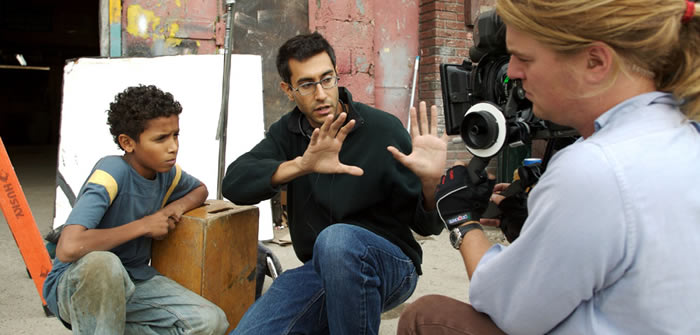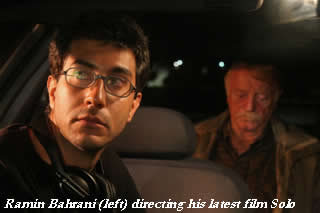 Born and raised in the United States, Ramin Bahrani studied film at Columbia University in New York City before moving to his parents’ homeland of Iran, where he lived for three years. After spending time in Paris, he eventually returned to the United States to begin work on his first feature film, MAN PUSH CART (2005). The film premiered at the Venice Film Festival (2005) and was selected for the Sundance Film Festival (2006) before being released theatrically to critical acclaim. His second feature film, CHOP SHOP (2007) premiered at the Cannes Film Festival and screened next at The Toronto Film Festival. Bahrani is currently finishing his third feature, SOLO.
Born and raised in the United States, Ramin Bahrani studied film at Columbia University in New York City before moving to his parents’ homeland of Iran, where he lived for three years. After spending time in Paris, he eventually returned to the United States to begin work on his first feature film, MAN PUSH CART (2005). The film premiered at the Venice Film Festival (2005) and was selected for the Sundance Film Festival (2006) before being released theatrically to critical acclaim. His second feature film, CHOP SHOP (2007) premiered at the Cannes Film Festival and screened next at The Toronto Film Festival. Bahrani is currently finishing his third feature, SOLO.
Chop Shop is the story of Alejandro, a 12 year-old, tough and ambitious street orphan on the verge of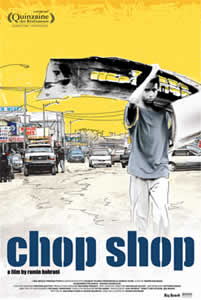 adolescence, and his 16 year old sister Isamar, live and work in the sprawling auto-body repair shops on the outskirts of Queens, New York. In this chaotic world of adults, young Alejandro struggles and sacrifices to make a better life for himself and his older sister.
adolescence, and his 16 year old sister Isamar, live and work in the sprawling auto-body repair shops on the outskirts of Queens, New York. In this chaotic world of adults, young Alejandro struggles and sacrifices to make a better life for himself and his older sister.
Bijan Tehrani: How did you come up with the idea of making the Chop Shop?
Ramin Bahrani: While editing Man push cart in 2004, my cinematographer, Michael Simmonds, had to get his car fixed. He knew I would like willet’s point (the location of the film) and so he invited me to join him. I was amazed by what I saw. I ended up spending over one and a half years in the location, which is twenty blocks of junkyards, dumping grounds, and row upon row of auto-body repair shops. Over seventy-five years ago, F. Scott Fitzgerald described it as “the valley of the ashes” in the Great Gatsby. more recently the current mayor of New York has named it, “the bleakest point of New York.” across the street from the junkyards and repair-shops looms Shea baseball stadium, whose giant billboard reads, “Make dreams happen.” I was curious to know what dreams can happen in this place, and who these dreamers were. The more time I spent there, the more I was drawn to the lives of the young kids who work and live in the auto-body shops. My story is about one of them, a 12-year-old Latino who struggles at any cost to make a better life for him and his16-year-old sister.
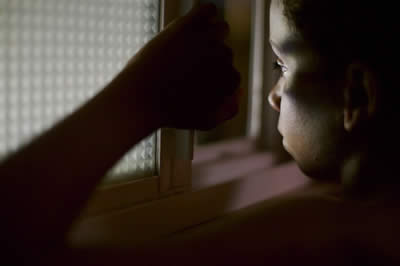 Bijan: Chop Shop like Man Push Cart portrays an unknown world to most of its audience in US, is there any connection between the two films?
Bijan: Chop Shop like Man Push Cart portrays an unknown world to most of its audience in US, is there any connection between the two films?
Ramin: I see every film as its own entity. It begins and ends with itself. we must accept that i am making films about how the majority of people in this world live, and we must also accept that this majority is utterly ignored by Hollywood and independent film (or belittled and exploited by using famous rich actors to play the roles of the economically poor in order for said actors to try and win awards). Thus, you may say that the connection between the two films is there, but as relevant as saying I am making films about people and the human condition in the “modern” globalized world.
Bijan: There are people that after watching Chop Shop and learning that it is happening in New York, believe that this is totally fictional or it is about a young kid in a unique and exceptional situation. What is your answer?
Ramin: I am flattered that they think I can make this up. I would ask anyone who doubts that this film depicts a reality to follow the directions below to Willet’s Point Queens, and when they arrive to ask for rob at Jamaica auto body glass.
•#7 subway line to Willets Point/Shea Stadium
•Long Island Railroad (LIRR) stops at Shea Stadium along its Port Washington line
•Grand Central Parkway
oEast. To Northern Blvd/Shea Stadium (Exit 9E).
oWest. To Northern Blvd/Shea Stadium (Exit 9W).
•Van Wyck/Whitestone Expressway
oWhitestone-south. To Linden Blvd (Exit 14), turn left on College Point Blvd. Right on Roosevelt Ave.
oVan Wyck-north. To Northern Blvd West/Shea Stadium (Exit 13W).
•Long Island Expressway (LIE)
oEast. Midtown Tunnel to LIE to Grand Central-west (exit 22A).
oWest. To Grand Central-west (exit 22A).
Bijan: Alejandro Polanco and Isamar Gonzales play their parts so naturally that there is hard to believe there has been a camera present to shoot the scenes. Watching Chop Shop I totally forgot I am watching a film. How could you get such performances from these young kids?
Watching Chop Shop I totally forgot I am watching a film. How could you get such performances from these young kids?
Ramin: Thank you for saying this. The kids are amazing actors with incredible talent and determination. They had never acted or studying acting before playing in Chop Shop. We rehearsed for over six months; they never saw the scri pt, but memorized very scri pted dialogues and their own improvisations of the dialogue. I made Alejandro work for rob at the chop shops for nearly six months prior to making the film. As a rehearsal, we also shot the entire film, on location, with a small Handi-Cam in order to prepare them and the residents of the chop shops to the idea of a camera, of being filmed and of being watched. This proved invaluable, because when we shot the film for real, with a large camera and a crew, the actors had all stopped caring about the camera entirely. What also impressed me about Ale and Izzy is that they accomplish nearly every scene in one shot, without cutting, while hitting marks in very complicated blocking in an extremely chaotic and unpredictable location. Even for a professionally trained actor, this would be almost impossible.
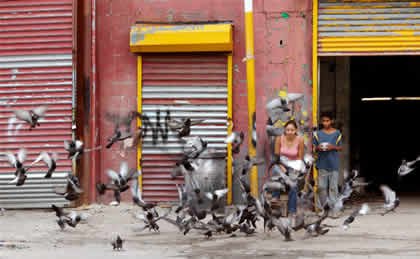 Bijan: Ahmad Razvi ‘s part was also artistically played by him. His character in Chop Shop is very different from his part in Man Push Cart. Could he be Ahmad in Chop Shop be the continuation of the life of Ahmad in Man Push Cart?
Bijan: Ahmad Razvi ‘s part was also artistically played by him. His character in Chop Shop is very different from his part in Man Push Cart. Could he be Ahmad in Chop Shop be the continuation of the life of Ahmad in Man Push Cart?
Ramin: I see the film as two separate works. Ahmad in Chop Shop is such a different character. He speaks more (and lies more) in one scene of Chop Shop than he does in the entire Man push cart! I think he has proven with this film that he was not “just being himself” in Man push cart, which is the standard underhanded compliment some people give non-professionally trained actors. Ahmad, like Alejandro and Isamar, is an actor. He has proven it again in Chop Shop. The second he is on camera, he is impossible to ignore.
Bijan: A few film critics believe you work has a touch of Kiarostami look to the world and style of film making. But I have found you quite unique, you dare to get close to your character and still don’t dramatize the situations. I find the kind of support for those in poverty who are in majority and I could see it in Satyajit Ray films. What’s your own take on this?
Ramin: You have just mentioned two of my heroes and masters. If Bresson and Kiarostami are important to me by keeping a respectful distance from subject and story, then I would say that I stray by allowing and encouraging emotion from my actors. As for Satyajit Ray, if I could have one scene with as much humanity and compassion as in any of Ray’s films, then I feel I would be taking steps in the right direction.
Bijan: How did you come up with visual style of the Chop Shop?
Ramin: Michael Simmonds and I (the amazing cinematographer for Man push cart and also the film I just finished shooting, Solo) decided one year in advance that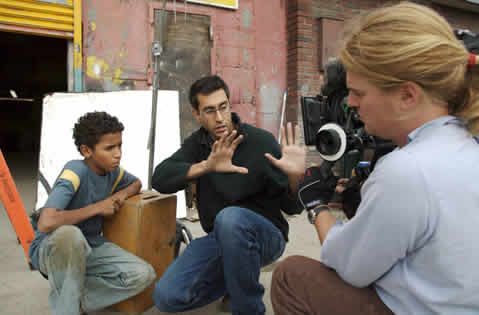 the film had to be hand-held. We also agreed that it should not be a very shaky or jittery hand-held. We knew we should remain close to Alejandro, but never too close as I do not like to disrespect the actor and their privacy. We shot almost entirely on a 50 mm lens. Nearly every scene happens in one shot, with complicated mise-en-scene. What you are seeing is usually take 30, even if it feels like take 1 or a documentary. It has all been planned out. Simmonds and I wanted to erase the camera and I wanted to erase myself. To be invisible and to film things as simply as possible– or at least make you think it was simple and effortless. To direct everything without appearing to have directed anything. That was the goal.
the film had to be hand-held. We also agreed that it should not be a very shaky or jittery hand-held. We knew we should remain close to Alejandro, but never too close as I do not like to disrespect the actor and their privacy. We shot almost entirely on a 50 mm lens. Nearly every scene happens in one shot, with complicated mise-en-scene. What you are seeing is usually take 30, even if it feels like take 1 or a documentary. It has all been planned out. Simmonds and I wanted to erase the camera and I wanted to erase myself. To be invisible and to film things as simply as possible– or at least make you think it was simple and effortless. To direct everything without appearing to have directed anything. That was the goal.
Bijan: What was the most challenging aspect of making Chop Shop?
Ramin: The constant lying to make you think it simply happened and that we were lucky enough to be there filming it. Thus– everything.
Bijan: What was the reaction of your young actors after watching the film?
Ramin: Isamar, who did not know anything about the film beyond her scenes, was shocked to learn that Alejandro had stolen in the film to make money to protect her. Alejandro was thrilled to hear himself cursing in the film! In Cannes, he was really moved to receive a standing ovation at the world premiere, to be hugged and kissed by Kiarostami, and then to have his photo in Le Monde! I would also add that in their next school year, both Alejandro and Isamar found themselves on the honor roll for the first time.
Bijan: When will be the theatrical release of Chop Shop?
Ramin: Deals are being closed now for US, UK & France. Other countries will follow.

